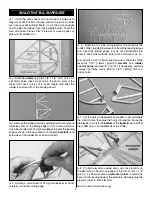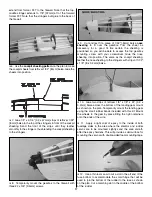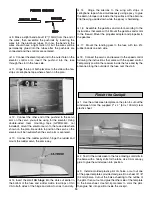
❏
1. For safety, remove the propeller from the motor. Move
the throttle stick to the off position, or towards the bottom of
the transmitter. Turn on the transmitter. Connect the charged
battery to the speed control then, follow the instructions that
came with the speed control to turn on the receiver.
❏
2. Center the trims on the transmitter. Operate the servos
by moving the control sticks. Check that the servos respond
in the correct direction as shown in the diagram. If
necessary, use the servo reversing function on your
transmitter to get the controls to respond correctly.
❏
3. If necessary, remove the servo arms from the servos,
then remount them so they are centered.
❏
4. Now that the servos and the servo arms are centered,
center the rudder and elevator by adjusting the position of
the wire pushrod ends in the pushrod tubes. Once the
controls are centered, permanently glue the pushrod ends
into the pushrod tubes with thin CA. If the ailerons require
adjustment, carefully bend the aileron torque rods or the
pushrods until both ailerons are centered.
❏
Operating the controls with the transmitter, use a ruler to
measure the throws at the widest part of the surface. If
necessary, reposition the pushrods on the servo arms
(farther out for more throw, closer in for less throw), or use
the ATV function on the transmitter to set the control throws
according to the chart that follows.
Follow the instructions that came with your radio to charge
the batteries the evening before you plan to fly. You should
always charge the transmitter batteries before flying and at
other times as recommended by the radio manufacturer.
Charge the Transmitter Batteries
PREFLIGHT
These are the recommended control throws:
Elevator:
5/8" [16mm] up 5/8" [16mm] down
Rudder:
1" [25mm] right 1" [25mm] left
Ailerons:
5/8" [16mm] up 1/8" [3mm] down
IMPORTANT:
The Li’l Poke has been extensively tested.
These are the control throws at which it flies best. If, after
you become comfortable with the way the Li’l Poke flies, you
would like to adjust the throws to suit your taste, that is fine.
However, remember that too much throw can make the
plane more difficult to control and force it into a stall or a
snap roll, so remember, “more is not always better.”
Set the Control Throws
4-CHANNEL
TRANSMITTER
TRANSMITTER
4-CHANNEL
TRANSMITTER
4-CHANNEL
TRANSMITTER
4-CHANNEL
Warning:
When not flying or working on the model, the
battery should be disconnected.
Set Up the Radio
21






































